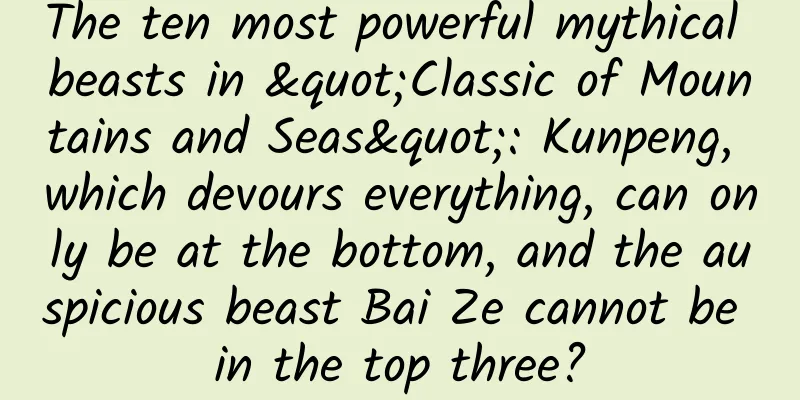The ten most powerful mythical beasts in "Classic of Mountains and Seas": Kunpeng, which devours everything, can only be at the bottom, and the auspicious beast Bai Ze cannot be in the top three?

|
As a famous ancient book of strange stories in my country, "Classic of Mountains and Seas" contains many powerful mythical beasts. Today, Yiming will take you to take stock of the ten most powerful mythical beasts in "Classic of Mountains and Seas". Kunpeng, which is thousands of miles long, can only rank eighth. The first one can turn the world from day to night with just closing his eyes. Who are these ten mythical beasts? And how powerful are they? The tenth ferocious In the Classic of Mountains and Seas, Zheng is a kind of auspicious beast that looks like a leopard and appears in the Classic of Mountains and Seas: Classic of Western Mountains. The monster described in the Classic of Mountains and Seas lived on the Zhang'e Mountain. This mountain was very rich and full of precious jades. The monster guarded the wealth of the mountain and did not allow anyone to approach. Because he has five tails and a single horn on his head, he looks very intimidating, so no one dares to mess with him. The early image of Zhe was that of a ferocious beast with iron teeth and copper fangs, and a bloody mouth that could knock a person's head off with just a single opening and closing of its mouth. It was extremely terrifying. It is also very brutal, even tigers and lions are its food. It is immune to all poisons and can eat poisonous insects raw, much like Bear Grylls, who only eats the heads of insects. Later, when it was causing troubles in the world, it happened to be encountered by the passing Zhulong, who easily defeated it, so Zhulong captured it and made it his pet. After being tamed by Zhulong, all the fierceness of Zhe disappeared, and it became a kind beast. After coming down the mountain, Zhe liked to help mortals. Although mortals avoided it at first because of its ferocious appearance, after a long time, after getting used to its hideous face, people regarded it as a lucky beast that saved the world and helped people. Ninth place: Three Blue Birds The Three Green Birds are also called the Blue Birds. They appear in the "Western Mountains Classic", "Hainei Bei Jing" and "Dahuang Xi Jing" of the "Classic of Mountains and Seas". Legend has it that the Three Pure Birds are divine birds that fetch food for the Queen Mother of the West and are the messengers of the Queen Mother of the West. Mythology says that these three blue birds are actually the predecessors of the phoenix. They can fly a thousand miles in an instant with their wings spread. They are extremely fast. And because they have a light body, a very delicate appearance, and bright blue feathers, they are named the three blue birds. The three blue birds are only the size of black birds and are very much loved by the Queen Mother of the West. Every time the Queen Mother of the West arrives, the three blue birds will come to announce the arrival in advance. Over time, people regard it as an auspicious bird that brings happiness and joy. Even Li Bai used it to describe the urgency of lovesickness in his poems: "I wish that the three blue birds would repay my everlasting love for you." Eighth place: Kunpeng Kunpeng is an extremely huge monster in "Classic of Mountains and Seas". Everyone must have read the poem "Xiao Yao You" written by Zhuangzi for it: "There is a fish in the North Sea, named Kun. Kun is so big that no one knows how many thousand miles it is. It changes into a bird, named Peng. Peng's back is so big that no one knows how many thousand miles it is. When it flies in anger, its wings are like clouds hanging from the sky. This bird, if it travels by sea, will migrate to the South Sea. The South Sea is the Tianchi. From Zhuangzi's few short words, we can see that Kunpeng is extremely huge and rare. How long is a thousand miles? From Beijing to Shanghai is only a thousand kilometers. If Kunpeng is only considered as a thousand miles long, its size is enough to cover the entire three northeastern provinces. According to the overall area of the earth, one hundred Kunpengs are enough to cover the entire sky of the earth. This is enough to show the size of Kunpeng. Human beings are like a speck of dust in front of it. There is also a Buddhist-related legend about Kunpeng. The Kunpeng described in Buddhist scriptures is actually the golden-winged Peng bird, also called "Garuda", the guardian beast of Buddhism. Although it is impossible to verify whether this statement is true or not, it is enough to show how high the status of the mythical beast Kunpeng is in the hearts of mortals. 7. Dijiang Dijiang is also called "Dihong". It is not only a mythical beast in the Shanhaijing, but also a god in ancient Chinese mythology. Emperor Hong is often regarded as the ancestor of the Chinese nation, Huangdi. It is written in Zhuangzi: Responding to the Emperor: The emperor of the South Sea is Zhuan, the emperor of the North Sea is Hu, and the emperor of the Central Sea is Hun Dun. Hun Dun here refers to Emperor Jiang, and the Central God is our legendary ancestor Huangdi. The image of Dijiang is rather peculiar. "Classic of Mountains and Seas: Western Three Classics" says that his overall appearance is like a yellow flesh bag with soft and fluffy hair on the outside. He was born with four legs and two pairs of wings on his back for flying. Perhaps it is the so-called "one cannot look directly at the face of God", or maybe he was really born like this, Dijiang's image has always been headless and faceless, not to mention ears, nose and mouth, just like a faceless beast. Although it has no ears, it is very good at singing and dancing, and can dance to the music. Of course, it is also possible that it has a lively personality and likes to jump around. Although it looks like a ferocious beast, it is actually an auspicious beast that symbolizes singing and dancing, so it is ranked seventh. 6. Kuiniu Kui is also called Kuiniu. Kui looks like a cow and its cry is like the roar of the sky. Kuiniu is a strange beast that lurks in the East China Sea in the Classic of Mountains and Seas. It lives in Boliu Mountain. The Classic of Mountains and Seas gives a brief description of him, saying that he is a cow with only one foot and no horns on his head. When he appears, there must be a storm, and his roar is as strong as thunder, so people also think he is a thunder beast or a rain beast. His body was shining with light, as dazzling as the sun. After Huangdi captured Kui Niu, he made a giant drum with the fur of Kui Niu and used the hardest leg bones of Kui Niu as drumsticks. This huge drum is extremely powerful, and its sound is like thunder, resounding through the sky. Hitting it once can shock the enemy, hitting it twice can make the enemy's legs weak, and hitting it three times can make people surrender. It has even reached the level of a mysterious magic weapon. When Huangdi was fighting Chiyou, he only struck the Kuiniu drum nine times and Chiyou was unable to fly anymore. This shows how magical the Kuiniu is, and it is reasonable that it ranks sixth. Fifth place: Bifang Bifang is one of the ancient mythical beasts in my country. Like Zhe, he is a mythical beast living in Zhang'e Mountain. The Bifang in the Classic of Mountains and Seas is a mythical bird that looks very much like a crane, but it has only one leg. Bifang has green feathers all over its body, with red spots dotted on its wings, and looks very beautiful. Although Bifang is a divine bird, he is actually very mischievous. He would often pick up sticks with flames on them and throw them into other people's homes, causing fires, and he enjoyed watching other people's backyards catch fire. Therefore, ordinary people often blame Bifang for the cause of the fire in order to exonerate themselves, which shows people's fear of fire. Therefore, Bifang is often regarded as a firebird and worshipped as the god of fire. Fourth place: Bai Ze Speaking of Bai Ze, there have been more and more creations about Bai Ze in recent years, and he can often be seen in various books or film and television dramas. Bai Ze is a beast of good fortune in ancient my country. He can speak human language, has spiritual powers, and knows everything in the three realms. Legend has it that he only appears when a wise ruler is born. He is a very mysterious beast. Bai Ze looks like a very authentic auspicious beast, with a tiger head, hair as red as the Vermilion Bird, two horns on his head, a dragon body behind, and four legs. Legend has it that he has the ability to bring life and avoid death, and is a symbol of longevity, auspiciousness, and warding off evil. Therefore, in ancient times, two stone statues of Bai Ze would be placed outside many gates to pray for warding off evil and eliminating disasters. Because of its auspicious nature, people have been particularly worshipping Bai Ze for thousands of years, and often create works related to Bai Ze. Even the official uniforms of some dynasties would have Bai Ze elephant patterns embroidered on them. Such an auspicious and legendary Bai Ze can only be ranked fourth. How powerful are the top three mythical beasts in the Classic of Mountains and Seas? Don't worry, let's continue watching. The third Phoenix The phoenix, also known as the "Phoenix Emperor", is the king of birds in ancient mythology and a symbol of good luck. Since ancient times, the phoenix, worshipped by hundreds of birds, has been mentioned in all Chinese myths and legends. It is very famous, and many poets have written poems about it to praise its name. According to my rough calculation, there are more than 130 poems about it, which is enough to show how famous it is. It first appeared in the Classic of Mountains and Seas, which records: "On the Danxue Mountain, there lives a bird that looks like a chicken, with five colors and patterns, and its name is Fenghuang." Since then, the word "Phoenix" has appeared frequently in people's eyes. People describe the emperor as a dragon and the empress as a phoenix. People also frequently include the word "phoenix" in their names when giving girls the hope that their daughters can soar like a phoenix in the future. It is a yearning for a better life. Ancient bronze wares, jewelry, and accessories were often engraved with phoenix patterns to indicate status. There was even a "phoenix fever" during the Tang Dynasty. People often use the phoenix to metaphorically represent beautiful things, and also to symbolize a happy marriage. The most famous story is the phoenix hairpin. Even in the "Complete Tang Poems", the words "phoenix" and "huang" appear more than 3,000 times, which shows the high status of the phoenix in ancient times. Second place: Yinglong Yinglong is also one of the mythical beasts in ancient my country. He is the dragon beside Emperor Huangdi. It is recorded in the "Classic of Mountains and Seas: Great Wilderness North Classic" that when Chiyou attacked Huangdi, Yinglong fought for Huangdi and made great contributions to him. Yinglong is also called Gengchen. In some Chinese myths, he is even regarded as the ancient dragon god of creation and is also called Zulong, with a very high status. The "Tai Zang Jing" even says that he is the mother of the phoenix and the unicorn, and the ancestor of all dragons. There are many different opinions about Yinglong in the world, but in every legend, he appears as the supreme being, which shows the lofty belief of the people in dragons. Yinglong is a mythical beast that existed in the ancient times. The description of its size in the Classic of Mountains and Seas is even more exaggerated than that of Kunpeng. It is said that it can be as small as the void and as big as the universe, and its size is quite terrifying. In the ancient Chinese mythology system, Yinglong is in charge of the four seasons of heaven and earth, Zhongyue Zhongtu, and the descendants of Yan and Huang, and his status and position are unmatched. Yinglong looks similar to the traditional Chinese dragon. Its golden scales show its noble temperament, and its colorful wings are extraordinary and beautiful. It can be said that it is the embodiment of all the beauties in the universe, and it also symbolizes the highest form of people's beautiful yearning for mythical animals. It is well deserved to be ranked second. Even a supreme mythical beast like Yinglong can only rank second. Who is the number one mythical beast in the Classic of Mountains and Seas? Don’t worry, I will reveal to you the number one mythical beast in "Classic of Mountains and Seas" next! The first Zhulong Zhulong, also known as Zhu Jiuyin, is the most powerful being in ancient Chinese mythology. When his eyes are open it is day, and when his eyes are closed it is night. In Chinese mythology, no one else has such powerful abilities except him. He is undoubtedly the number one mythical beast in the Classic of Mountains and Seas. Who is the most powerful mythical beast in the Classic of Mountains and Seas in your mind? |
>>: These on the sea surface will destroy the marine food chain! (Not white garbage)
Recommend
Yuanfudao product analysis!
With the continuous development of the Internet, ...
They are not the same species, I almost believed it
In the human world, people often look alike. It&#...
What role does the operations manager of a mobile game company play?
In the eyes of many people, mobile gaming is a hi...
Electric stove, induction cooker, ceramic stove, which one should you choose for making tea around the stove?
Boiling tea around the stove, the warmth and the ...
World Economic Forum: Top 10 Emerging Technologies for 2021
The World Economic Forum's 10th anniversary e...
Android development SMS verification code example
Before talking about the knowledge point of SMS v...
The best way to dry your quilt, you will never think of it
The quilt can be said to be our good comrade who ...
Schneiss successfully renewed its IATF16949 quality system, helping the automotive industry upgrade its quality
Recently, Schnais announced that its IATF16949 qu...
6 suggestions to create an operational promotion plan that can be implemented!
Whether you are a novice in website operation or ...
Android Q lets users manage location permissions elegantly
[[262144]] Apps can use location data to bring An...
Scientific Exploration丨China’s first major rescue: How to find an escape route for whales away from human interference?
At 5:30 in the morning of April 20, the rising su...
A 200-pound crocodile drowned? Don't laugh, crocodiles are also afraid of choking on water, okay?
For the crocodile, the "king of the water&qu...
Build a 20W+ private domain traffic pool from 0 to 1!
According to the "2019 Private Domain E-comm...
3D printing technology can also make electric cars. The key is low cost.
Honda has developed a short-range "Micro Com...
First look at the project
Open VS2015, create a Web project, select ASP.NET...









